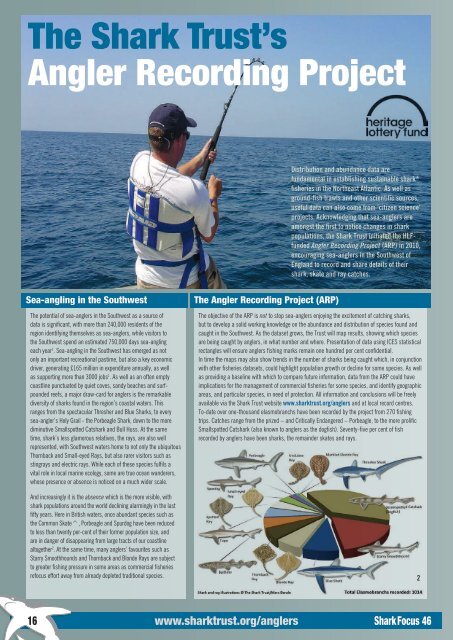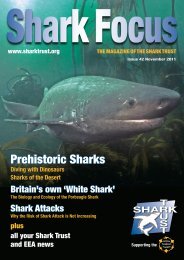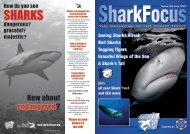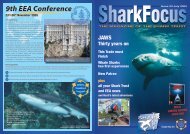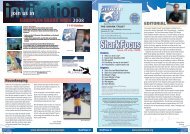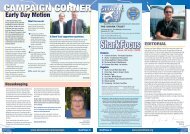Shark Focus
here - The Shark Trust
here - The Shark Trust
You also want an ePaper? Increase the reach of your titles
YUMPU automatically turns print PDFs into web optimized ePapers that Google loves.
The <strong>Shark</strong> Trust’sAngler Recording ProjectSea-angling in the SouthwestThe potential of sea-anglers in the Southwest as a source ofdata is significant, with more than 240,000 residents of theregion identifying themselves as sea-anglers, while visitors tothe Southwest spend an estimated 750,000 days sea-anglingeach year 1 . Sea-angling in the Southwest has emerged as notonly an important recreational pastime, but also a key economicdriver, generating £165 million in expenditure annually, as wellas supporting more than 3000 jobs 1 . As well as an often emptycoastline punctuated by quiet coves, sandy beaches and surfpoundedreefs, a major draw-card for anglers is the remarkablediversity of sharks found in the region’s coastal waters. Thisranges from the spectacular Thresher and Blue <strong>Shark</strong>s, to everysea-angler’s Holy Grail - the Porbeagle <strong>Shark</strong>, down to the morediminutive Smallspotted Catshark and Bull Huss. At the sametime, shark’s less glamorous relatives, the rays, are also wellrepresented, with Southwest waters home to not only the ubiquitousThornback and Small-eyed Rays, but also rarer visitors such asstingrays and electric rays. While each of these species fulfils avital role in local marine ecology, some are true ocean wanderers,whose presence or absence is noticed on a much wider scale.And increasingly it is the absence which is the more visible, withshark populations around the world declining alarmingly in the lastfifty years. Here in British waters, once abundant species such asthe Common Skate^, Porbeagle and Spurdog have been reducedto less than twenty per-cent of their former population size, andare in danger of disappearing from large tracts of our coastlinealtogether 2 . At the same time, many anglers’ favourites such asStarry Smoothhounds and Thornback and Blonde Rays are subjectto greater fishing pressure in some areas as commercial fisheriesrefocus effort away from already depleted traditional species.The Angler Recording Project (ARP)Distribution and abundance data arefundamental in establishing sustainable shark*fisheries in the Northeast Atlantic. As well asground-fish trawls and other scientific sources,useful data can also come from ‘citizen science’projects. Acknowledging that sea-anglers areamongst the first to notice changes in sharkpopulations, the <strong>Shark</strong> Trust initiated the HLFfundedAngler Recording Project (ARP) in 2010,encouraging sea-anglers in the Southwest ofEngland to record and share details of theirshark, skate and ray catches.The objective of the ARP is not to stop sea-anglers enjoying the excitement of catching sharks,but to develop a solid working knowledge on the abundance and distribution of species found andcaught in the Southwest. As the dataset grows, the Trust will map results, showing which speciesare being caught by anglers, in what number and where. Presentation of data using ICES statisticalrectangles will ensure anglers fishing marks remain one hundred per cent confidential.In time the maps may also show trends in the number of sharks being caught which, in conjunctionwith other fisheries datasets, could highlight population growth or decline for some species. As wellas providing a baseline with which to compare future information, data from the ARP could haveimplications for the management of commercial fisheries for some species, and identify geographicareas, and particular species, in need of protection. All information and conclusions will be freelyavailable via the <strong>Shark</strong> Trust website www.sharktrust.org/anglers and at local record centres.To-date over one-thousand elasmobranchs have been recorded by the project from 270 fishingtrips. Catches range from the prized – and Critically Endangered – Porbeagle, to the more prolificSmallspotted Catshark (also known to anglers as the dogfish). Seventy-five per cent of fishrecorded by anglers have been sharks, the remainder skates and rays.2The project currently has a range of recorders, includingindividual anglers, charter skippers, as well as anumber of official ‘Fish Recorders’ and presidents ofsea-angling clubs throughout the Southwest. From theoutset, several of the Southwest’s larger clubs haveexpressed an interest in the contributing to the project,including Mounts Bay Angling Society, Clevedon Pier SeaAngling Club , the <strong>Shark</strong> Angling Club of Great Britain(Looe), Bristol Channel Federation of Sea Anglers,Mevagissey Sea Angling Club and the Poole DolphinsSAC. Collectively, these clubs represent a significantnumber of anglers throughout the region and theirsupport is vital. Although falling outside the project area,records are also coming from the south coast of Wales.Due to the highly migratory nature of many shark species(Blue and Porbeagle <strong>Shark</strong>s in particular), these recordsare important as a means of better understanding theirabundance and distribution throughout Southwestwaters.ResourcesA wide range of hard-copy and online resourceshave been developed to support the project, many ofwhich are available via the dedicated webpage atwww.sharktrust.org/anglers. These include a splashproofproject handbook, ID Guides for the most commonlycaught elasmobranchs and Sea-angling Advisories,detailing legislation and restrictions currently applicableto a small number of species.3The Trust has also produced a CD-ROM – <strong>Shark</strong>s: IdentifyRecord Release, containing all of these resources. To-datealmost 500 copies of the CD-ROM have been distributedto interested individuals and organisations throughoutthe Southwest and further afield. The disc also containsa short film with advice on ‘best practice’ handling ofmedium to large sharks (e.g. Tope, Blues, Porbeagle)– crucial information as sharks can be unintentionallyinjured (sometimes fatally) as the animals are boarded,the hook removed, photographed and returned to thewater. The Trust also produces a twice-yearly newsletterto keep project participants informed and interested.Media and publicityThe project and its resources have been widely promotedthroughout UK angling media, including by the fourmost prominent publications: Total Sea Fishing, BoatFishing Monthly, Sea Angler and Sea Angling News, withsimilar coverage planned for 2013. This project has alsoreceived excellent coverage in regional newspapers andmagazines.TripsThe <strong>Shark</strong> Trust has visited key angling centres in Dorset,Devon and Cornwall – including Brixham, Dartmouth,Weymouth, Poole, Newlyn, Looe and Penzance. Duringthese trips, staff promoted the project to charterskippers, angling clubs and organisations, tackleshops and enforcement officers (Marine ManagementOrganisation). In Looe, the Trust promoted the ARP atthe registration night for the <strong>Shark</strong> Fishing Club of GreatBritain’s summer <strong>Shark</strong> Fishing Festival – perhaps thepreeminent UK shark fishing competition. This year theTrust intends to visit angling centres in North Cornwall,North Devon and Somerset – including Newquay,Padstow, Appledore, Ilfracombe and Minehead, as wellas revisiting angling centres mentioned above.The next stepAlthough more than one thousand elasmobranchs havebeen recorded so far, at present the dataset is not largeenough to infer population trends such as changes indistribution or abundance. But as more anglers getinvolved and more records come in, this will change –in the process putting sea- anglers at the forefront ofmonitoring the health of shark populations throughout theSouthwest.What the project can do right now, however, isdemonstrate to policy-makers that sea-anglers are asignificant stakeholder group with an interest in thedevelopment and implementation of sustainable fisheriespolicy. It also reveals this group is not sitting back andhoping for the best. Instead sea-anglers are proactivelyengaging in projects like the ARP in order to betterunderstand and sustainably manage UK shark, skate andray populations.The ARP will continue to promote the importance ofcatch and release for all elasmobranchs, including usingtotal-length and girth measurements to estimate weight(an alternative to landing and killing sharks to weighthem). In parallel with this will be the development ofresources demonstrating correct handling of sharks, withthe aim of minimising impact on fish during capture andrelease.45ChallengesLike similar projects before it, the ARP is viewed withscepticism by some sea-anglers, with previous catchrecord collation projects failing to keep participantsinformed of progress or provide access to the project’sconclusions. One consequence is that many anglers feelthat any information they supply with the best intentionswill either end up in a data ‘black hole’ or be used toregulate their ability to fish when and wherever theywish.The <strong>Shark</strong> Trust is working hard to keep participantsin the ARP regularly updated and informed, as well asclearly stating how the data will be used. At the sametime the Trust will ensure that: A] participants are ableto access records and information upon request B]fishing marks remain confidential and C] results andconclusions will be made available to all participants andinterested stakeholders.The final issue the project must contend with is theseasonal nature of sea angling. With all but a minority ofhard-core anglers halting fishing in winter months, thereare very few records coming in between November andMarch.References1. Invest in Fish South West. 2005. The Motivation, Demographicsand Views of South West Recreational Sea Anglers and their SocioeconomicImpact on the Region. 118 pp.2. IUCN 2012. IUCN Red List of Threatened Species. Version 2012.1.www.iucnredlist.org. Downloaded on 09 October 2012.* Unless specifically stated otherwise, ‘sharks’ refers to all sharks,skates and rays which form the subclass elasmobranchii.^ Genetic research has confirmed the species previously known asthe Common Skate Dipturus batis is in fact two distinct species: theFlapper Skate Dipturus c.f. intermedia and the Blue Skate D. c.f. batis.Main image: Sea Angling. © L. Suff.Image 2: ARP catch composition.Image 3: ARP resources.Image 4: Blonde Ray Raja brachyura. © Sally Sharrock.Image 5: Thornback Ray Raja clavata. © Steve Andrew.16 www.sharktrust.org/anglers <strong>Shark</strong> <strong>Focus</strong> 46<strong>Shark</strong> <strong>Focus</strong> 46 www.sharktrust.org/anglers 17


